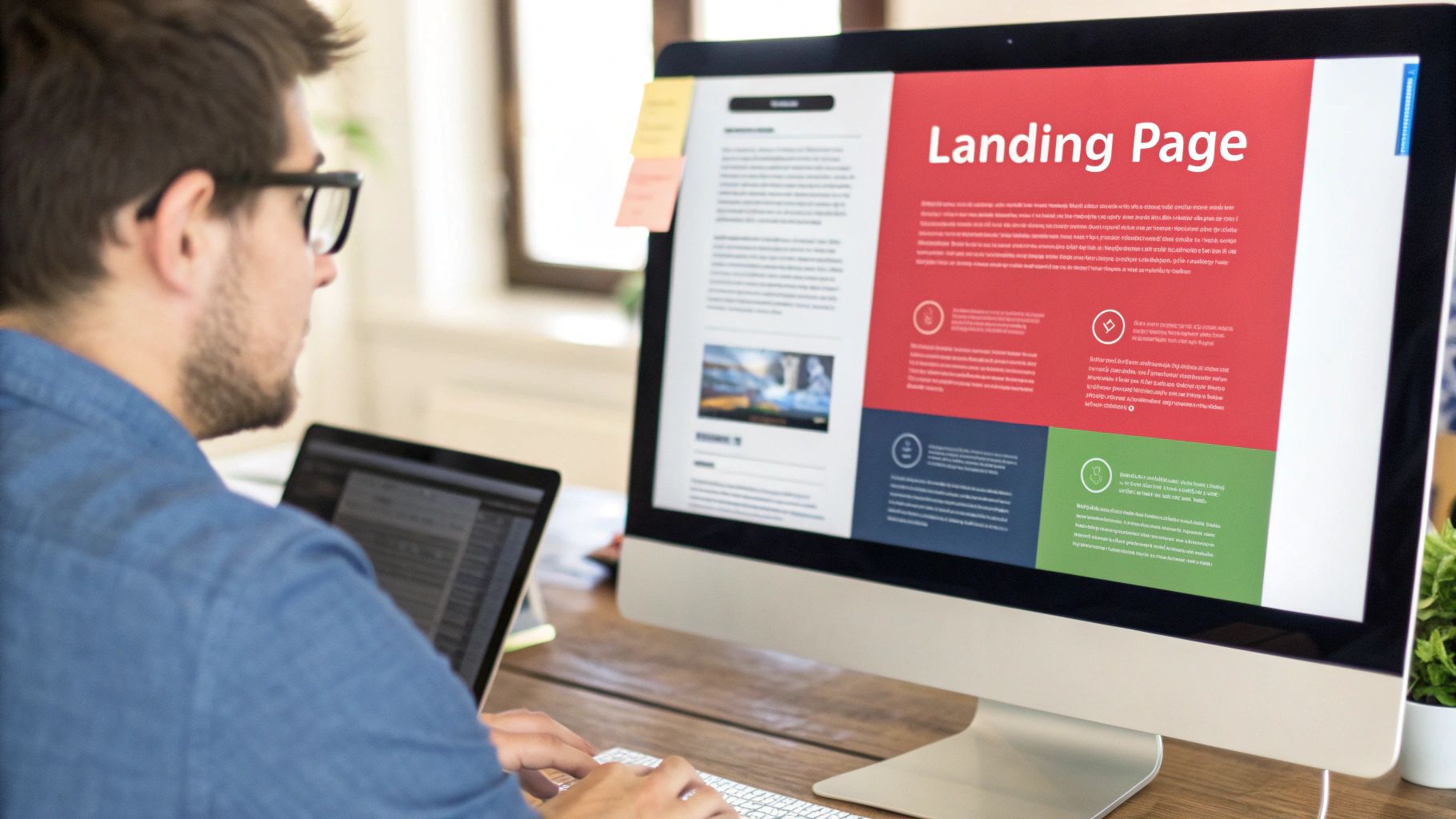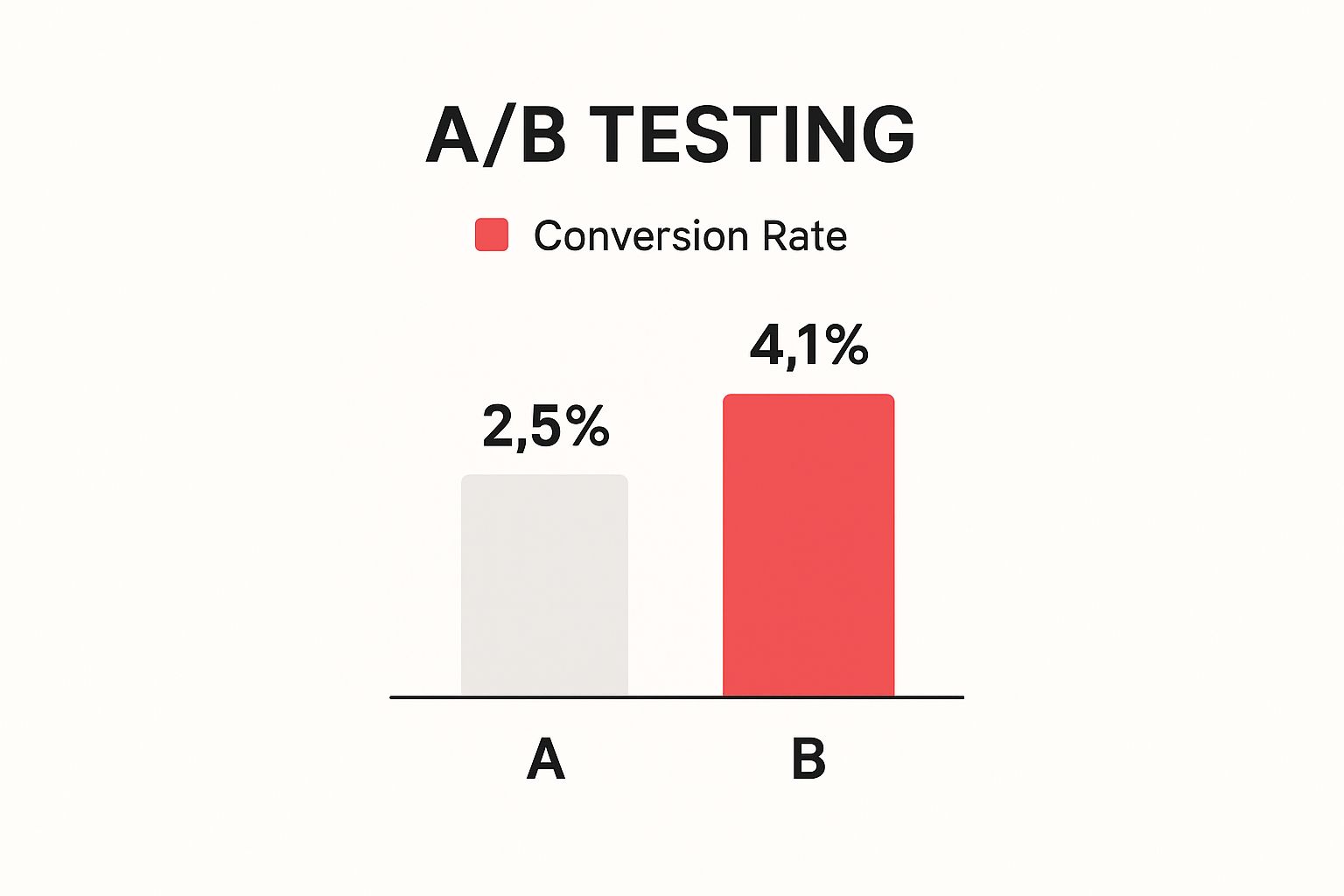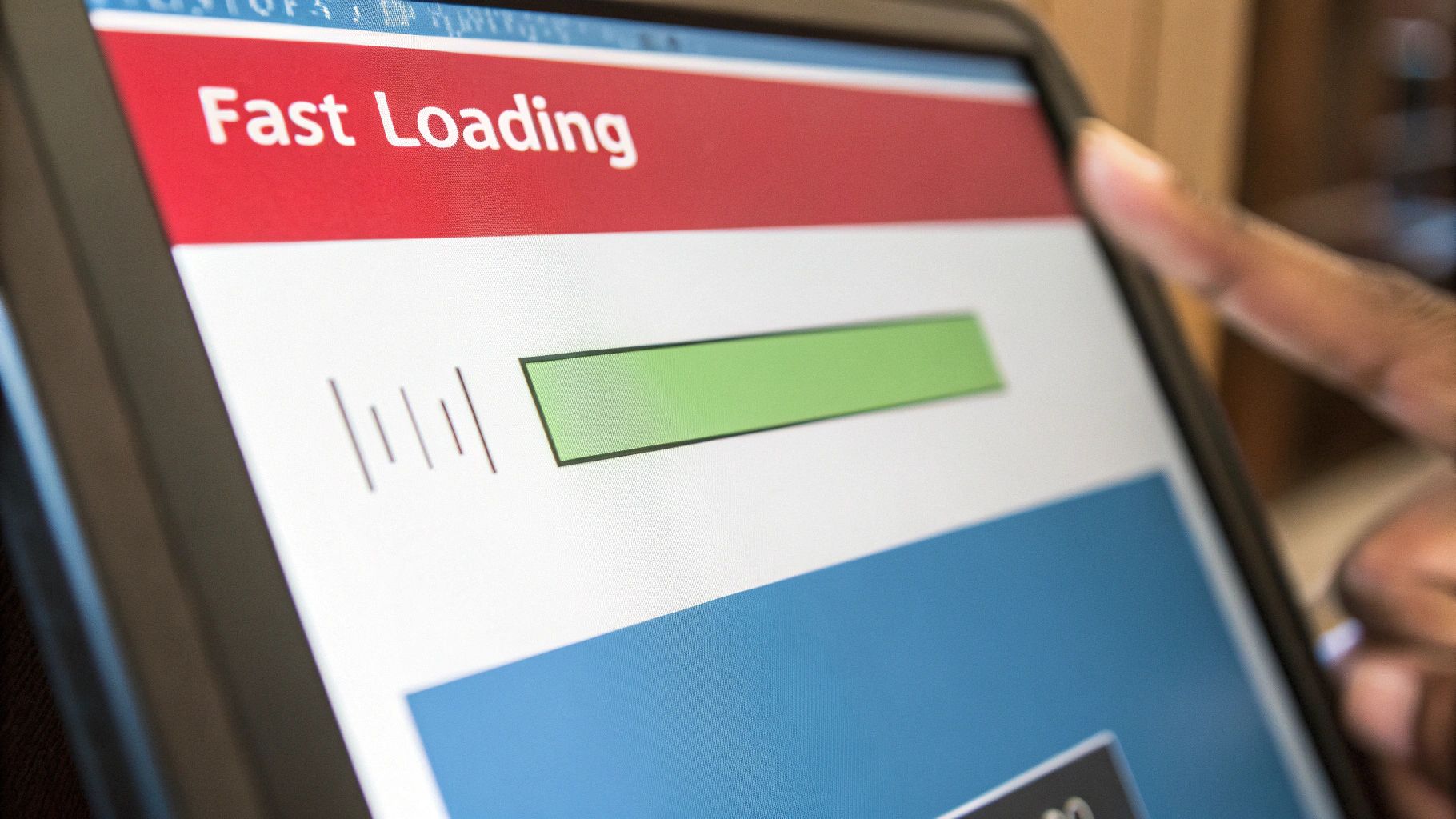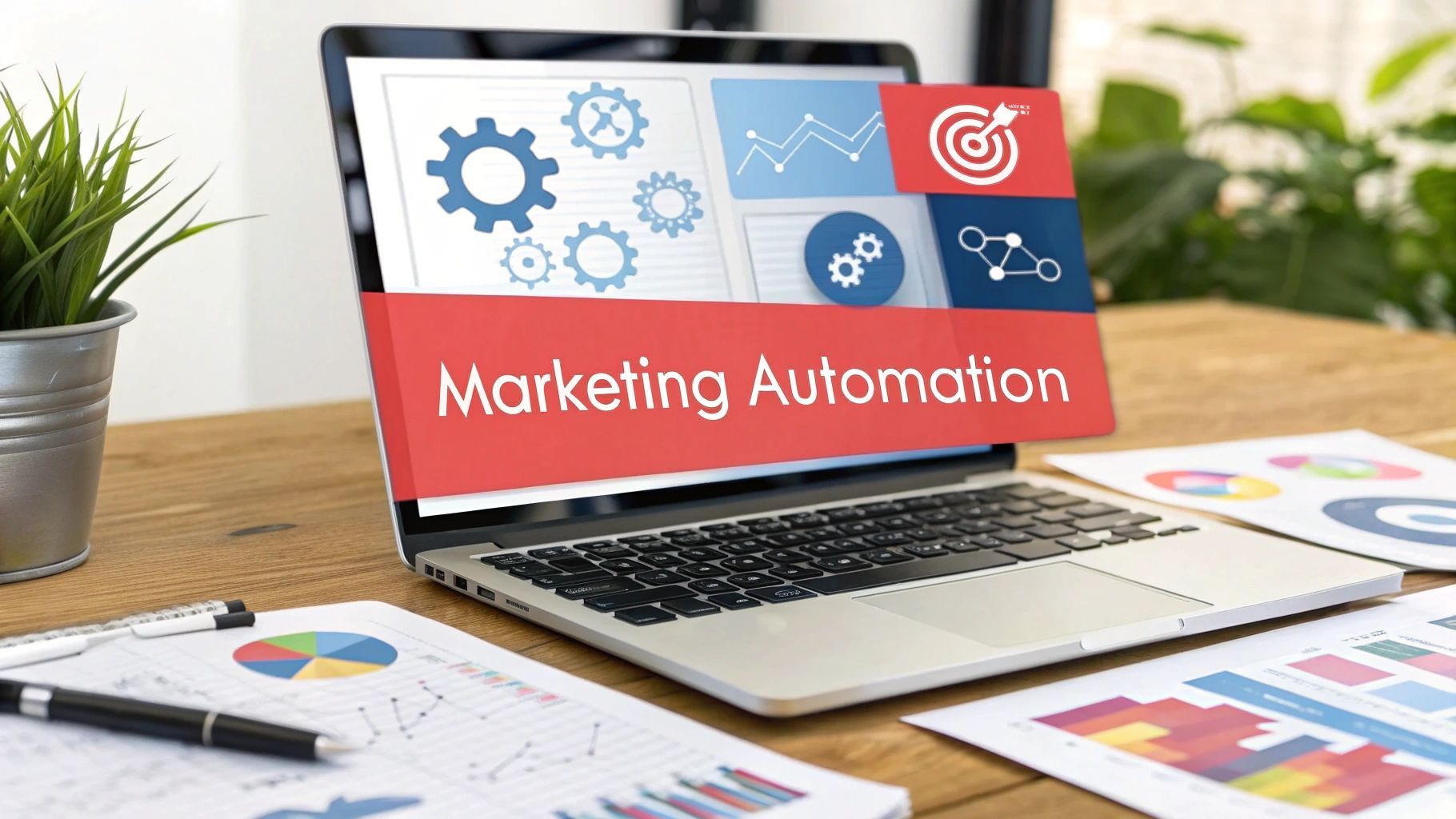How to Improve Website Conversion Rates for UK Businesses
Boosting your website's conversion rate is not about guesswork. It is a methodical process of auditing what is working, figuring out what is not, and making data backed changes. By digging into user behaviour with tools like heatmaps and sharpening your calls to action, you can smooth out the bumps in the user journey and guide more visitors towards a sale.
Establishing Your Conversion Baseline
Before you can start improving anything, you need a brutally honest picture of where you stand right now. Establishing a clear conversion baseline is the first, non-negotiable step. This moves you from acting on assumptions to building a plan based on hard data—it is the foundation for everything that follows.
This is not just about glancing at your total sales for the month. It is about taking a deep dive into your sales funnel and seeing your website through your customers' eyes. You need to find the exact moments where potential buyers lose interest, hit a wall, and decide to leave.
Understanding Your Current Performance
First things first, let us get into the data. The goal here is to map out the user journey, highlighting both the wins and the weak spots. You are looking for the "leaks" in your funnel—those pages with shockingly high exit rates or where engagement just dies.
Start by pulling these numbers:
- Overall Conversion Rate: The big one. What percentage of visitors actually complete the goal you have set for them (e.g., make a purchase, fill out a form)?
- Funnel Drop off Rates: Pinpoint which stage of the process, from landing page to the thank you page, is losing the most people. Is it the product page? The checkout?
- Page Specific Metrics: Get granular. Look at bounce rates, time on page, and exit rates for crucial pages like your homepage, key product pages, and the checkout flow.
This kind of dashboard from Google Analytics gives you a solid overview of user acquisition and behaviour, which is the perfect starting point for any performance audit.
From here, you can start to see which channels are bringing in quality traffic and where users are getting stuck and dropping off.
Setting Realistic Benchmarks
It is absolutely vital to set goals that make sense for your specific industry. Comparing your high end fashion e-commerce site to a food delivery service is a pointless exercise; their customer behaviours and buying cycles are worlds apart. Looking at UK specific industry data shows just how much these benchmarks can vary.
UK E-commerce Conversion Rate Benchmarks by Industry
A summary of average conversion rates across different UK e-commerce sectors to help you set realistic performance goals.
| Industry Sector | Average Conversion Rate (%) |
|---|---|
| Personal Care | 6.8% |
| Food & Beverages | 4.9% |
| Home & Garden | 2.5% |
| Fashion & Apparel | 1.9% |
| Jewellery & Accessories | 1.9% |
| Electronics | 1.8% |
Sectors like personal care ( 6.8% ) and food & beverages ( 4.9% ) often see higher conversion rates, driven by frequent repeat purchases. In contrast, industries with a longer consideration phase, like fashion or jewellery, average a much lower 1.9% . Knowing where you fit in gives you the context you need to set achievable targets.
A baseline is not just a number; it is a story. It tells you where your customers are succeeding and, more importantly, where they are struggling. Your first job is to listen to that story.
To get a true understanding of which marketing efforts are actually driving results and establish your baseline accurately, it is worth reading a comprehensive guide to modern marketing attribution. This will help you assign the right value to all the different touchpoints in your customer's journey.
By harnessing the power of data-driven marketing strategies for success , you can build a smarter, more targeted optimisation plan from day one. This methodical approach ensures your time and money are spent on the areas that will make the biggest difference to your bottom line.
Attracting Traffic That Actually Converts

It is easy to get excited about a surge in website visitors, but that excitement fades fast if none of them are actually buying. A high traffic number with a low conversion rate is just a vanity metric.
The real work of improving conversions does not start on your landing page. It begins way before that, with the quality of the audience you attract in the first place. You have to get the right people through the door.
Think about it: not all traffic is created equal. Understanding where your visitors come from tells you a lot about their intent. Some channels just naturally deliver more engaged, ready to buy customers, making them a much smarter place to focus your marketing budget.
For UK businesses, the data is pretty clear. Visitors arriving via email newsletters or referrals convert at an average rate of around 5% . That is a huge leap compared to organic search traffic at roughly 2% . And it leaves social media and display ads, which convert at less than 1% , in the dust. You can dig into more e-commerce benchmarks on clevertap.com to see for yourself.
This is exactly why building a strong email list and referral network is not just a nice to have; it is a commercial necessity.
Refining Your Marketing for High Intent
To get those conversion rates climbing, you have to align your campaigns with user intent. This means getting specific. Move beyond generic keywords and start targeting long tail phrases that scream "I am ready to buy!"
Someone searching for "best running shoes for flat feet" is miles ahead in the buying journey compared to someone just typing in "running shoes".
The same logic applies to your paid advertising. Stop casting a wide, expensive net and start building laser focused campaigns aimed at narrow customer profiles. Use the demographic, interest, and behavioural data at your fingertips to build audiences who are a perfect match for what you sell. It is about precision, ensuring every penny of your ad spend is working to attract people who are genuinely likely to convert.
Here are a few practical ways to target high intent traffic:
- Get Granular with Keywords: Focus on long tail keywords that include buying signals like "buy", "deal", "discount", or even specific product model numbers.
- Segment Your Audiences: On your ad platforms, do not just target all website visitors. Create lookalike audiences based on your best existing customers—the ones who spend more and come back.
- Build Smart Remarketing Funnels: Do not show the same ad to everyone. A user who abandoned their shopping basket needs a different message (maybe a gentle nudge or a discount) than someone who only glanced at your homepage.
Nurturing Leads with Targeted Content
Let us be realistic: most people who land on your site for the first time are not ready to pull out their wallets. Many are still in the research or consideration phase, and your job is to guide them, not push them.
This is where targeted content marketing comes in. By creating genuinely valuable content that solves your audience's problems and answers their questions, you build trust and position your brand as the go to expert.
The goal is to build a relationship before you ask for the sale. When a visitor sees you as a trusted resource, the eventual conversion becomes a natural next step, not a hard sell.
Imagine a company that sells high end coffee machines. Instead of just pushing products, they could create:
- A detailed guide on "How to Choose the Right Espresso Machine for Your Home".
- Video tutorials comparing different brewing methods.
- An interactive quiz to help users find their perfect coffee bean profile.
This kind of content is not about the immediate sale. It is about educating, engaging, and earning the user's trust. You capture their interest—and often their email address in exchange for a downloadable guide—and then you can continue to nurture that relationship. With a steady flow of helpful tips and exclusive offers, you gently guide them toward a purchase when the time is right for them.
Designing a Frictionless User Journey
Let us be blunt: a confusing or slow website is a guaranteed conversion killer.
You have done the hard work of getting the right people to your site. Your next job is to make their experience so smooth and intuitive that clicking ‘buy’ feels like the most natural thing in the world. This is all about spotting and fixing the design and usability issues that cause people to leave.
Think of your website like a physical shop. If the aisles are cluttered, the lighting is dim, and finding the till is a mission, people will just walk out. It is exactly the same online. Every bit of friction in the user journey leads straight to abandoned baskets and lost sales.
Optimising for the Mobile Majority
It is a familiar story: people browse on their phones but often wait until they are on a desktop to actually buy.
The data backs this up. In the UK, desktop users consistently convert at a higher rate—around 4.8% , compared to just 2.9% on mobile. The gap is usually down to clunky mobile experiences. But with mobile now driving over 70% of all e-commerce traffic, fixing this is not just an opportunity; it is essential. For more benchmarks, check out the latest insights from SpeedCommerce.com.
To close this conversion gap, your mobile site cannot just be a shrunken down version of your desktop site. It needs to be built for the phone from the ground up.
- Thumb Friendly Navigation: Are your buttons and links big enough to tap easily without zooming in? Your menus should be simple and always within reach.
- Simplified Forms: Nobody wants to fill out a long form on a small screen. It is a massive pain point. Cut it down to the absolute essentials.
- One Handed Use: Think about how people actually hold their phones. Key actions, like "Add to Basket", should be easy to reach with a thumb.
We have put together a quick checklist to help you think through the key differences between optimising for mobile versus desktop.
Mobile vs Desktop UX Optimisation Checklist
Optimising for user experience is not a one size fits all job. What works brilliantly on a large desktop monitor can be a disaster on a mobile screen. This table breaks down the crucial differences you need to consider to ensure a seamless experience, no matter the device.
| UX Element | Key Consideration for Mobile | Key Consideration for Desktop |
|---|---|---|
| Navigation | Simple, collapsible menus (like a hamburger menu). Prioritise core actions in a sticky bottom bar for thumb access. | Full navigation menus are expected. Use hover states and dropdowns to reveal more complex site structures. |
| Forms & Input | Minimise fields. Use device features like numeric keypads for phone numbers and autofill where possible. | Can handle more complex forms. Use clear labels and logical grouping. Multi-column layouts can work well. |
| Calls to Action (CTAs) | Large, full width buttons that are impossible to miss and easy to tap. Use clear, concise text. | CTAs can be more nuanced, incorporated alongside other content. More screen space allows for secondary CTAs. |
| Content Layout | Single column layout is a must. Focus on vertical scrolling and scannable content with short paragraphs. | Multi column layouts are effective. Prioritise a clear visual hierarchy to guide the user's eye across the page. |
| Images & Media | Optimise images aggressively for speed. Ensure videos are 'tap to play' to save data and avoid autoplaying sound. | High resolution imagery is expected. Autoplaying muted videos can be effective for engagement. |
Ultimately, the goal is to respect the user's context. A mobile user is often on the go and needs speed and simplicity, while a desktop user has more screen real estate and attention to spare for a richer experience. Catering to both is non-negotiable.
Slashing Page Load Times
In e-commerce, every single second counts. A study by Deloitte and Google revealed that a tiny 0.1 second improvement in load time can boost conversions by 8.4% . The moment your page takes longer than three seconds to load, you are haemorrhaging potential customers.
Page speed is not just some techy metric; it is a fundamental part of the user experience. A slow site feels unprofessional and frustrating, chipping away at the trust you need to make a sale.
Your website's speed is one of the very first impressions you make. A fast, responsive site tells the user you are professional and reliable. A slow one plants a seed of doubt before they have even seen what you are selling.
Want to make an immediate impact? Start by compressing your images. Huge, unoptimised image files are the number one culprit behind slow loading pages. Switching to modern formats like WebP can slash file sizes without wrecking the visual quality, giving you a quick and noticeable performance win.
Building an Effortless Checkout Process
The checkout is the final hurdle, and it is where an astonishing number of sales are lost. A complicated, long, or untrustworthy checkout is the ultimate conversion killer. The goal is simple: make paying feel so easy it is almost an afterthought.
Here is what a frictionless checkout needs:
- Offer Guest Checkout: Forcing people to create an account is a massive barrier. Always, always provide a guest checkout option for new customers.
- Visual Progress Bar: Show people exactly where they are in the process (e.g., Shipping > Payment > Confirm). It manages their expectations and stops them from feeling like they are stuck in an endless loop.
- Display Trust Signals: Make your security badges (like SSL certificates) and accepted payment logos (Visa, PayPal, etc.) impossible to miss. This instantly reassures users that their details are safe.
A great checkout respects the customer's time and provides constant reassurance. Many of these principles are also covered in our deep dive on the anatomy of a high-converting landing page , as the psychology behind them is very similar.
Sometimes, a tiny change can make a huge difference, as this simple A/B test shows.

The results speak for themselves. Variant B, with a 4.1% conversion rate, completely outperformed Variant A’s 2.5% . It is a perfect illustration of why you should never stop testing and refining your design.
Writing Copy and CTAs That Drive Action

Think of the words on your website as your best salesperson. They are working 24/7 to persuade, guide, and reassure every single person who lands on your page. Great design might catch the eye, but it is the copy that truly connects with a visitor’s needs and gets them to take that next step.
It all starts with knowing who you are talking to. Your copy needs to speak directly to their pain points, using their language and showing that you genuinely understand the hurdles they are facing. When someone feels seen and understood, you start building trust. That trust is what makes them open to hearing about your solution.
This is a shift away from just listing features. Nobody really cares what your product does; they care what it does for them. How does it make their life easier, save them time, or fix a problem that has been bugging them for ages? That is what you need to tell them.
Crafting Headlines That Compel
Your headline is your first impression. Often, it is your only impression. It has one critical job: grab attention and make the visitor want to know more. A vague, boring headline is a one way ticket to a high bounce rate.
A killer headline screams value. It is specific, punchy, and laser focused on the result your visitor is looking for.
Here are a few angles that work:
- The Direct Benefit: "Get Flawless Skin in 30 Days."
- The Question: "Struggling to Keep Your Houseplants Alive?"
- The Social Proof: "Join 10,000+ UK Businesses Growing with Our Software."
Each one instantly answers the silent question in your visitor’s mind: "What is in it for me?" They set the stage perfectly, promising a clear path from problem to solution.
Writing Product Descriptions That Sell
A great product description does not just describe; it sells an experience. This is your chance to paint a vivid picture of how your customer's life will improve with your product. Use sensory language and focus on the transformation they will feel.
But it is not just about the big picture. You also need to tackle the small moments of hesitation. This is where microcopy comes in—the tiny, reassuring bits of text near buttons and forms.
Microcopy is the unsung hero of conversion. Phrases like "Cancel anytime", "Fast, free delivery", or "We will never share your email" seem small, but they dismantle the little walls of doubt that stop people from clicking.
Readability is also non-negotiable. Use short sentences and bullet points. Give your words room to breathe with plenty of white space. A dense wall of text is an immediate turn off. Remember, your tone of voice isn't fluff; it's a revenue tool and it needs to be consistent and clear at every single touchpoint.
Designing Calls to Action That Are Impossible to Ignore
Your call to action (CTA) is the final nudge. It needs to be bold, direct, and persuasive. Forget generic buttons like 'Submit' or 'Click Here'. They are lazy, they lack urgency, and they are a huge missed opportunity.
The best CTAs are packed with action and a clear benefit. Instead of 'Submit', try 'Get My Free Guide' or 'Start My 30-Day Trial'. The user knows exactly what they are getting when they click.
The button design is just as important.
- Colour and Contrast: Your CTA needs to pop. Pick a colour that stands out against the background but still feels on brand.
- Size and Placement: Make it big enough to be unmissable, especially on a phone, and place it right where someone would naturally look for it.
- Surrounding Space: Do not crowd your CTA. White space around the button gives it prominence and draws the eye right to it.
When you blend persuasive, benefit led copy with a strategically designed CTA, you create a clear, compelling path that guides visitors from curiosity to commitment.
Building a Culture of Continuous Optimisation

Here is a hard truth: improving your website’s conversion rates is not a project you can just tick off a list. It is a total shift in mindset. You need to move away from the big, scary, once every few years redesign and embrace a rhythm of constant, tiny improvements.
This approach weaves optimisation into the fabric of your daily work, making sure your site is always evolving to meet your customers' needs better than it did yesterday.
The real goal is to build a culture that runs on data. Every change, no matter how small, becomes an experiment. Instead of getting stuck in debates based on gut feelings, your team starts asking, "How can we test that?"
It creates a powerful feedback loop. You come up with an idea, you test it, you learn from what happens, and you do it all over again. This takes the pressure off getting everything perfect right away and instead puts the focus on learning and making steady progress.
A/B Testing, Demystified
The engine behind this continuous optimisation is A/B testing . You might have heard it called split testing, but the idea is simple: you compare two versions of a webpage to see which one gets better results.
You show one version (the 'A' version, or the control) to one group of visitors, and a slightly different version (the 'B' version, or the variation) to another. The key is to only change one thing at a time . If you tweak the headline and the button colour, you will never know which change actually made the difference.
By measuring which version gets more sign ups, sales, or whatever your goal is, you get undeniable proof of what your audience really responds to.
A/B testing is brilliant because it kills subjective debates. It stops the endless back and forth about which design is "better" and just gives you a clear winner based on how real people behave.
You can learn more about practical ways to implement this through A/B testing for landing pages to really start refining your website elements.
Finding the High Impact Tests
You could test almost anything on your website, but let us be realistic—your time and resources are not infinite. You have to be smart and prioritise the tests that could actually move the needle in a big way.
Start by focusing on your high traffic pages. Think about it: even a tiny percentage lift in conversions on a page that gets thousands of visitors can mean a serious boost to your bottom line.
Here are a few of the most valuable things you can test:
- Headlines & Subheadings: This is the first thing people read. Try out different angles—focus on a clear benefit, spark curiosity, or hit an emotional trigger.
- Call to Action (CTA) Buttons: Play around with the text ("Get Started" vs. "Claim Your Free Trial"), the colour, the size, and even where it sits on the page.
- Hero Images & Videos: That main visual sets the whole tone. Test a clean product shot against a lifestyle image showing someone using it. The results might surprise you.
- Page Layout: Sometimes, just shuffling the order of your content can have a massive impact. What happens if you move your glowing customer testimonials higher up the page to build trust sooner?
Do Not Forget the 'Why'
A/B testing is fantastic at telling you what is happening, but it often leaves you guessing why. To get the full picture, you need to pair that quantitative data with qualitative feedback—the real thoughts and feelings of your users.
Understanding their frustrations and motivations is how you come up with much stronger ideas for your next round of tests.
Here are a few simple ways to gather that feedback:
- On Page Surveys: Use a small pop up on key pages to ask a direct question. On a pricing page, for example, you could ask, "Is our pricing clear?"
- Feedback Widgets: Add a little feedback tab to the side of your site. It gives visitors an easy way to rate their experience or flag something that is broken.
- Post Purchase Questions: After someone buys from you, ask them what almost stopped them. Their answers can uncover friction points in your checkout that you never even knew existed.
When you blend the hard numbers with real human stories, you start to build a deep, three dimensional understanding of your customer experience. That is the foundation for a smart optimisation strategy that delivers real, long term growth.
Your Top Website Conversion Questions, Answered
As you start pulling apart your website's performance, questions are bound to come up. It is only natural. Diving into the data, figuring out what to test, and deciding where to focus can feel a bit overwhelming at first.
This section is all about giving you clear, no nonsense answers to the most common questions we get from UK businesses just like yours. Think of it as your field guide to cutting through the noise and applying these conversion strategies with confidence.
What Is a Good Conversion Rate for a UK Website?
This is the big one, the question everyone asks. And the honest answer? It completely depends on your industry. A "good" conversion rate is not some universal number you should be chasing.
For a typical UK e-commerce site, anything between 2% and 5% is usually seen as pretty solid. But even that is a huge range. A brand selling personal care products might hit 6.8% because of repeat buys and lower price points.
On the flip side, a luxury jewellery brand might see an average of 1.9% . That lower number is perfectly fine; it just reflects a more considered, expensive purchase.
Stop chasing a magic number. The single most important thing you can do is benchmark against your own industry and, even more importantly, focus on improving your own baseline. That is where real growth happens.
How Long Does It Take to See Results from CRO?
How long is a piece of string? The time it takes to see a real impact boils down to two things: the size of the change you are making and how much traffic your website gets. You need enough data for the results to be trustworthy, which means sites with more visitors often get answers faster.
Small, focused tweaks can show results surprisingly quickly. Testing a new headline or simply changing the colour of your main "buy now" button might give you a clear winner in an A/B test within a couple of weeks, as long as the traffic is there.
Bigger, more fundamental changes will take longer. If you are redesigning your entire checkout process, that is a bigger project that needs more time to build and even more time to gather enough data to prove it worked. The secret is consistency. A steady rhythm of testing will always uncover wins faster than one off, sporadic efforts.
Should I Focus on Desktop or Mobile Optimisation First?
Ah, the classic CRO dilemma. Your data probably shows that people on desktop are more likely to convert. But at the same time, most of your traffic is probably coming from mobile phones. So, where do you start?
Let your own analytics be the judge. Dive into your data and look at the two experiences side by side. If you find that mobile brings in 70% of your visitors but its conversion rate is miles behind desktop, you have just found your starting point. That gap is your biggest opportunity.
In today's world, a smooth mobile experience is not a "nice to have", it is non-negotiable. While desktop still matters, ignoring the device most of your audience uses is like leaving cash on the table. Start where your people are.
What Is the Most Important Thing to Test on My Website?
When you are just starting, it is easy to get analysis paralysis. There are so many things you could test. To get the best bang for your buck, start with the elements that have the biggest and most immediate influence.
Focus on everything 'above the fold' on your most important pages—your homepage, key product pages, and popular landing pages. This is the stuff everyone sees without having to scroll.
Here are your high impact candidates:
- Your Main Headline: It is your first, best shot at telling people they are in the right place.
- Your Primary Call to Action (CTA): The words, colour, and position of this button can make or break a conversion.
- Your Hero Image or Video: This is the big visual that sets the tone. It needs to connect instantly.
These elements make the first impression. A tiny change here can lead to a big shift in behaviour because it determines whether a visitor sticks around or hits the back button. Get these right, and you earn the right for them to see the rest of the page.
Ready to turn more visitors into loyal customers? The expert team at Superhub specialises in creating data driven strategies that deliver measurable results. Let us build a website experience that not only looks great but performs even better. Visit us today to start your growth journey.





